Abstract
In this contribution, we designed a 4,6-distyrylpyrimidine chromophore with diphenylamino electron-donating groups and biphenylenevinylene extended π-conjugated linkers. This compound has been synthesized in two steps from 4,6-dimethyl-2-phenylpyrimidine by a double Knoevenagel reaction with 4-bromobenzaldehyde followed by a double Suzuki–Miyaura cross coupling reaction with 4-(N,N-diphenylamino)phenylboronic acid. This compound exhibits intense emission in moderately polar solvents as well as in solid state. This compound is characterized by an intense emission solvatochromism with emission ranging from blue in non polar n-heptane to orange in dichloromethane. This chromophore is also sensible to the presence of acid with a bathochromic shift of the charge transfer absorption band and emission quenching.
1. Introduction
During the past two decades, there has been an important interest in the design of pyrimidine-based emissive materials [1,2]. The pyrimidine heterocycle is a six-membered aromatic ring with two nitrogen atoms in positions 1 and 3. Due to its π-deficient character, this heterocycle can be used as the electron-withdrawing part in push–pull structures [2] and the electron-lone pairs of the two nitrogen atoms are available for protonation, complexation and formation of hydrogen bonds, enabling us to tune the electron-withdrawing strength of this core [2,3]. Pyrimidine chromophores have been extensively used as fluorescent sensors for acidity [4], polarity [5], metal cations [6] or nitro-aromatic explosives [7]. Pyrimidine derivatives have also been used with success as emitters for organic light emitting diodes (OLEDs), in particular for third generation OLEDs based on thermally activated delayed fluorescence [8,9]. White light emission has also been described by controlled protonation of some pyrimidine compounds [4,10]. Finally, 4,6-distyrylpyrimidine derivatives are also well-known for their two-photon absorption properties and numerous structures have been developed for bio-imaging in particular [11]. In this short note we describe a new 4,6-distyrylpyrimidine emissive material combining diphenylamino strong electron-donating groups that is known to induce strong emission [12] and biphenylenevinylene extended π-conjugated linkers that should induce strong emission solvatochromism [13]. The presence of a phenyl ring in position 2 of the pyrimidine core may influence the photophysical and protonation properties of the chromophores.
2. Results and Discussion
2.1. Synthesis
The title compound was obtained in two steps from 4,6-dimethyl-2-phenylpyrimidine [14] (Scheme 1). The first step consists of a double Knoevenagel condensation with p-bromobenzaldehyde in a boiling 5 M aqueous solution of sodium hydroxyde in the presence of aliquat 336 as a phase transfer catalyst according to conditions initially described by Vanden Eynde [15]. The second step is a double Suzuki–Miyaura palladium catalyzed cross coupling reaction with p-(N,N-diphenylamino)phenylboronic acid leading to title compound 1 with a yield of 68%. The structure of compound 1 is confirmed by 1H and 13C-NMR as well as HRMS analysis. The E-stereochemistry of the double bond is confirmed by the coupling constant of ~16 Hz observed for the doublet at 8.16 ppm, corresponding to the vinylene linker (the second doublet is hidden in the massif around 7.20–7.10 ppm).
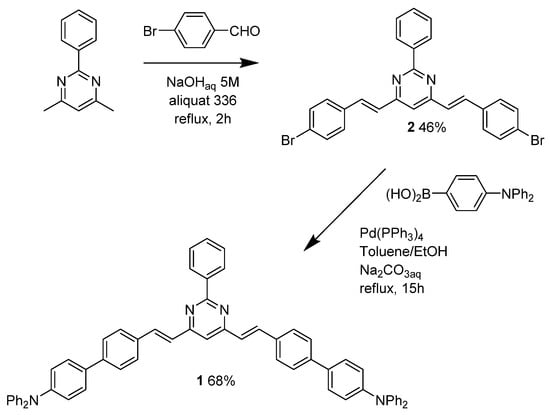
Scheme 1.
Synthesis of titled chromophore.
2.2. Photophysical Properties
The photophysical properties of the title compound were measured in a series of aprotic solvents of increasing polarity and the results are summarized in Table 1. Whatever the solvents, two absorption bands are observed, with the less energetic one around 400 nm being attributed to charge transfer. The normalized absorption and emission spectra in dichloromethane (DCM) are presented in Figure 1. In DCM, when compared with analogue pyrimidine chromophore bearing phenylenevinylene linkers instead of biphenylenevinylene bridges [16], a blue shift of 23 nm of the less energetic absorption band and a red shift of 53 nm of the emission band is observed. The analogue chromophore without the phenyl ring in the C2 position exhibits similar emission properties in DCM (λem = 485 nm) [13].

Table 1.
Photophysical properties of compound 1 in a series of aprotic solvents.

Figure 1.
Normalized absorption and emission spectra of 1 in DCM.
Whereas the position of the absorption spectrum is almost not sensible to the polarity of the solvent, a remarkable positive emission solvatochromism is noticed (Figure 2): a significant red shift of the emission band is observed when the polarity is increased, which is characteristic of luminescent push–pull materials because of the stabilization of a highly polar excited state in polar solvents [18]. In the most polar solvents tested, acetone and MeCN, the emission intensity is significantly reduced. Compound 1 exhibits one of the largest solvatochromic ranges observed for pyrimidine chromophore so far. Photoluminescence quantum yields of 0.87 and 0.83 have been measured in toluene and DCM, respectively.
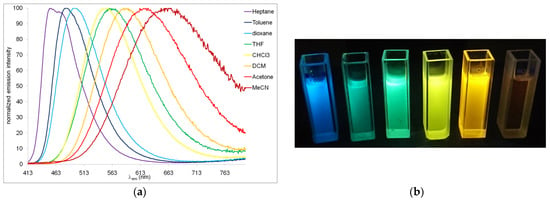
Figure 2.
(a) Normalized emission spectra of compound 1 in a series of aprotic solvents (λexc = 403 nm); (b) Fluorescence color changes experienced by 1 in various solvents (from left to right: n-heptane, toluene, 1,4-dioxane, chloroform, DCM and MeCN). The picture was taken in the dark upon irradiation with a handheld UV lamp (λem = 366 nm).
The effect of aggregation has also been examined by a progressive increase in the water ratio in the THF/water mixture (Figure 3). The addition of water up to 50% induces a dramatic decrease in emission intensity with an emission band that is red-shifted due to an increase in polarity. Then, when the water ratio increases up to 70%, an increase of emission intensity is observed with a slightly red-shifted band with regard to pure THF solution, which is attributed to the formation of aggregates. When the ratio of water is further increased, a slight decrease in emission intensity is observed and attributed to precipitation with a blue shift of the emission band. Solid state emissions in potassium bromide matrix were also tested (Figure 4) and an intense yellow emission at 545 nm was observed.
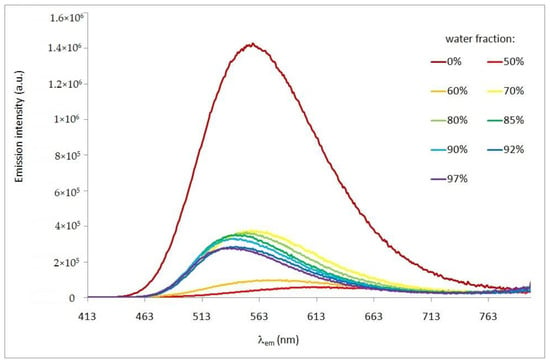
Figure 3.
Emission spectra of compound 1 in THF/water mixture (c = 1.5 × 10−5 M, λexc = 403 nm).
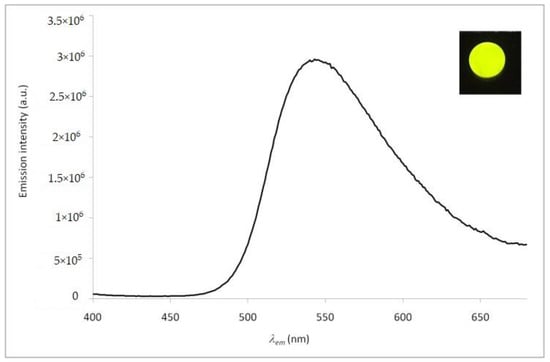
Figure 4.
Solid state emission spectrum of compound 1 in KBr pellet (3 wt% of 1) matrix. Inset: picture taken in the dark of the KBr pellet upon irradiation with a handheld UV lamp (λem = 366 nm).
Finally, the effect of protonation of the photophysical properties was tested. Figure 5 presents the effect of the progressive addition of trifluoroacetic acid (TFA) on the absorption and emission spectra of chromophore 1 in DCM. The addition of TFA leads to a decrease in the absorption band of the neutral form centered at 403 nm and the progressive appearance of a new red-shifted band centered at 544 nm, attributed to the protonated form of 1. The protonation of the pyrimidine reinforces its electron-withdrawing strength and induces an increased intramolecular charge transfer into the chromophore, resulting in a red shifted absorption. The pyrimidine ring is considered a monobase (pKa ~ 1.1). The protonation of the second nitrogen atom is not observed (pKa ~ −6.3). An isobestic point is observed at 438 nm. It should be noted that as already observed with push–pull chromophores with extended π-conjugated linkers [19], a large amount of acid is required to observe the formation of the protonation form. The protonation of 1 provokes an extinction of emission in DCM as generally observed for amino substituted pyrimidine chromophores [4]. However, in n-heptane, a low intensity emission centered at 706 nm is observed after the addition of a few drops of TFA with excitation at 530 nm (Figure S1). Emission quenching is observed in solvents of higher polarity after the addition of TFA.
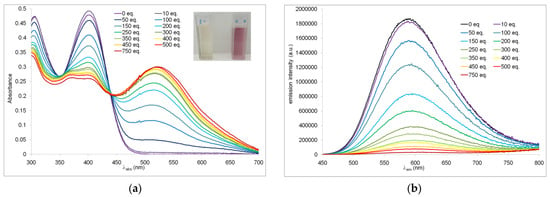
Figure 5.
(a) Change in the absorption spectra of a DCM solution of 1 (c = 9.4 × 10−6 M) upon addition of TFA (10–750 equiv) Inset: color change in a DCM solution of 1 upon addition of 750 equiv of TFA. (b) Change in the emission spectra of a DCM solution of 1 (c = 9.4 × 10−6 M) upon addition of TFA (10–750 equiv), λexc = 403 nm.
In summary, the distyrylpyrimidine chromophore 1 with extended π-conjugated linkers exhibited intense emission in solution and in solid state. Its important Stokes shifts and sensibility to acid and polarity with a huge emission solvatochromic range make this compound an interesting material for sensing applications.
3. Materials and Methods
3.1. General Informations
All solvents were reagent grade for synthesis and spectroscopic grade for photophysical measurements. The starting materials were purchased from Sigma-Aldrich or TCI (Sigma-Aldrich, Saint Louis, MO, USA or Tokyo Chemical Industry, Tokyo, Japan) and were used without further purification. NMR spectra were recorded in CDCl3 on a Bruker Avance 300 (1H at 300 MHz and 13C at 75 MHz) spectrometer (Bruker BioSpin GmbH, Rheinstetten, Germany). The chemical shifts δ are reported in ppm and are referenced to the residual protons of the deuterated solvent or carbon nuclei (1H, δ = 7.27 ppm; 13C, δ = 77.0 ppm). The coupling constants J are given in Hz. In the 1H-NMR spectra, the following abbreviations are used to describe the peak patterns: s (singlet), d (doublet), dd (doublet of doublets), t (triplet), and m (multiplet). Acidic impurities in CDCl3 were removed by treatment with solid K2CO3. Melting points (°C) were measured on a Kofler hot stage with a precision of 2 degrees (±2 °C). High-resolution mass analyses were performed at the ‘Centre Régional de Mesures Physiques de l’Ouest’ (CRMPO, Université de Rennes 1) using a Bruker MicroTOF-Q II apparatus. Analytical thin layer chromatography (TLC) was performed on silica gel plates (Merck 60 F254) and compounds were visualized by irradiation with UV light at 254 and 365 nm. Flash chromatography was performed using silica Acros SI 60 (60–200 mesh ASTM) (Acros, Geel, Belgium). UV-visible and fluorescence spectroscopy studies in solution were conducted on a Spex Fluoromax-3 Jobin-Yvon Horiba spectrophotometer (Horiba, Kyoto, Japan). Compounds were excited at their absorption maxima (band of lowest energy) to record the emission spectra. All solutions were measured with optical densities below 0.1. Fluorescence quantum yields (±10%) were determined relative to 9,10-bis(phenylethynyl)anthracene in cyclohexane (ΦF = 1.00) [20]. Acidic impurities in solvents were removed by treatment with Al2O3. Stokes shifts were calculated considering the lowest energetic absorption band.
3.2. Synthesis of 4,6-Bis((E)-4-bromostyryl)-2-phenylpyrimidine (2)
4-bromobenzaldehyde (1.11 g, 6.0 mmol), and 4,6-dimethyl-2-phenylpyrimidine (553 mg, 3.0 mmol) were added to 5 M aqueous NaOH (20 mL) containing Aliquat 336 (3 drops). The solution was heated to reflux for 2 h and then cooled to room temperature. The precipitate was filtered off, washed with water and purified by flash chromatography using DCM as eluent. Cream solid, 713 mg (46%), 1H-NMR (300 MHz, CDCl3) δ = 8.63–8.61 (m, 2H), 7.99 (d, 1H, J = 15.9 Hz), 7.58–7.52 (m, 10H), 7.17 (s, 1H), 7.14 (d, 1H, J = 15.9 Hz) 13C-NMR (75 MHz, CDCl3) δ = 164.3, 162.8, 138.1, 135.4, 134.9, 132.1, 130.6, 129.1, 128.5, 128.4, 127.0, 123.3, 114.5. HRMS (ESI/ASAP, TOF) m/z calculated for C43H34N3 [M + H]+ 516.9909 found 516.9911.
3.3. Synthesis of 4,6-Bis((E)-2-(4′-N,N-diphenylamino-[1,1′-biphenyl]-4-yl)vinyl)-2-phenylpyrimidine
A stirred mixture of 2 (515 mg, 1.0 mmol), 4-(N,N-diphenylamino)phenylboronic acid (722 mg, 2.5 mmol), 1 M aqueous sodium carbonate (2 mL) and ethanol (2 mL) in toluene (15 mL) was degassed in a Schlenk tube. Then, Pd(PPh3)4 (115 mg, 0.1 mmol) was added and the mixture was heated at reflux under nitrogen for 15 h. The reaction mixture was cooled, filtered and dissolved with a mixture of AcOEt and water 1:1 (50 mL) and the organic layer was separated. The aqueous layer was extracted with AcOEt (2 × 25 mL). The combined organic extracts were dried with MgSO4 and the solvents were evaporated. The crude product was purified by flash chromatography using a mixture of ethyl acetate and petroleum ether (1/4) as eluent. Yellow solid, 576 mg (68%), 1H-NMR (300 MHz, CDCl3), δ = 870–6.67 (m, 2H), 8.13 (d, 2H, J = 15.9 Hz), 7.76 (d, 4H, J = 8.1 Hz), 7.68 (d, 4H, J = 8.1 Hz), 7.59–7.56 (m, 7H), 7.36–7.30 (m, 9H), 7.21–7.13 (m, 13H), 7.10–7.07 (m, 4H) 13C-NMR (75 MHz, CDCl3), δ = 164.2, 163.0, 147.6, 141.4, 138.4, 136.2, 134.5, 134.0, 131.2, 130.5, 129.3, 128.5, 128.2, 127.6, 126.9, 126.2, 124.6, 123.7, 123.1, 114.2. HRMS (ESI/ASAP, TOF) m/z calculated for C62H47N4 [M + H]+ 848.0855 found 848.0857.
Supplementary Materials
The following are available online, Figure S1: Emission spectra of 1 in n-heptane after addition of excess TFA, Figures S2–S5: NMR spectra of compounds 1 and 2.
Author Contributions
Conceptualization, S.A.; methodology, S.A.; validation, S.A.; investigation, L.D. and S.A.; data curation, S.A.; writing—original draft preparation, S.A.; supervision, S.A. and F.R.-l.G.; funding acquisition, S.A. and F.R.-l.G. All authors have read and agreed to the published version of the manuscript.
Funding
This research received no external funding.
Institutional Review Board Statement
Not applicable.
Informed Consent Statement
Not applicable.
Data Availability Statement
Not applicable.
Conflicts of Interest
The authors declare no conflict of interest.
References
- Lipunova, G.N.; Nosova, E.V.; Charushin, V.N.; Chupakhin, O.N. Functionalized quinazolines and pyrimidines for opto-electronic materials. Curr. Org. Synth. 2018, 15, 793–814. [Google Scholar] [CrossRef]
- Achelle, S.; Rodríguez-López, J.; Robin-le Guen, F. Photoluminescence properties of aryl-, arylvinyl- and arylethynylpyrimi-dine derivatives. ChemistrySelect 2018, 3, 1852–1886. [Google Scholar] [CrossRef]
- Jindal, G.; Kaur, N. Biologically significant pyrimidine appended optical sensors: An inclusive anthology of literature from 2005 to 2020. Coord. Chem. Rev. 2021, 435, 213798. [Google Scholar] [CrossRef]
- Achelle, S.; Rodríguez-López, J.; Bureš, F.; Robin-le Guen, F. Tuning the photophysical properties of push-pull azaheterocyclic chromohpores by protonation: A brief overview of a French-Spanish-Czech project. Chem. Rec. 2020, 20, 440–451. [Google Scholar] [CrossRef] [PubMed]
- Itami, K.; Yamazaki, D.; Yoshida, J.-I. Pyrimidine-core extended π-system: General synthesis and interesting fluorescent proper-ties. J. Am. Chem. Soc. 2004, 126, 15396–15397. [Google Scholar] [CrossRef] [PubMed]
- Zhang, Q.; Tian, X.; Wang, H.; Hu, Z.; Wu, J.; Zhou, H.; Zhang, S.; Yang, J.; Sun, Z.; Tian, Y. NIR-region two-photon fluorescent probes for Fe3+/Cu2+ ions based on pyrimidine derivatives with different flexible chain. Sens. Actuators B Chem. 2016, 222, 574–578. [Google Scholar] [CrossRef]
- Verbitskiy, E.V.; Rusinov, G.L.; Chupakhin, O.N.; Charushin, V.N. Design of fluorescent sensors based on azaheterocyclic push-pull systems towards nitroaromatic explosives and related compounds: A review. Dye. Pigment. 2020, 180, 108414. [Google Scholar] [CrossRef]
- Komatsu, R.; Sasabe, H.; Kido, J. Recent progress of pyrimidine derivatives for high-performance organic light-emitting de-vices. J. Photonics Energy 2018, 8, 032108. [Google Scholar] [CrossRef]
- Pan, K.-C.; Li, S.-W.; Ho, Y.-Y.; Shiu, Y.-J.; Tsai, W.-L.; Jiao, M.; Lee, W.-K.; Wu, C.-C.; Chung, C.-L.; Chetterjee, T.; et al. Efficient and tunable thermally activated delayed fluorescence emitters having orientation-adjustable CN-substituted pyridine and pyrimidine acceptor units. Adv. Funct. Mater. 2016, 26, 7560–7571. [Google Scholar] [CrossRef]
- Achelle, S.; Rodríguez-López, J.; Cabon, N.; Guen, F.R.-L. Protonable pyrimidine derivative for white light emission. RSC Adv. 2015, 5, 107396–107399. [Google Scholar] [CrossRef]
- Fecková, M.; le Poul, P.; Bureš, F.; Guen, F.R.-L.; Achelle, S. Nonlinear optical properties of pyrimidine chromophores. Dye. Pigment. 2020, 182, 108659. [Google Scholar] [CrossRef]
- Gayatri, P.; Pannipara, M.; Al-Sehemi, A.G.; Anthony, S.P. Triphenylamine-based stimuli-responsive solid state fluorescent materials. New J. Chem. 2020, 44, 8680–8696. [Google Scholar] [CrossRef]
- Denneval, C.; Achelle, S.; Baudequin, C.; Robin-le Guen, F. Prediction of photophysical properties of pyrimidine chromophores using Tagushi method. Dye. Pigment. 2014, 110, 49–55. [Google Scholar] [CrossRef] [Green Version]
- Nishio, T.; Tokunaga, T.; Omore, Y. Reactions of β-sulfenyl α,β-unsaturated ketones with guanidine, amidines, and diamines. J. Heterocycl. Chem. 1985, 22, 405–407. [Google Scholar] [CrossRef]
- Eynde, J.-J.V.; Pascal, L.; Van Haverbeke, Y.; Dubois, P. Quaternary ammonium salt-assisted synthesis of extended π-systems from methyldiazines and aromatic aldehydes. Synth. Commun. 2001, 31, 3167–3173. [Google Scholar] [CrossRef]
- Achelle, S.; Bodiou, L.; Charrier, J.; Guen, F.R.-L. Incorporation of pyrimidine fluorophores into poly (methylmethacrylate) polymer structures. Comptes Rendus Chim. 2016, 19, 279–285. [Google Scholar] [CrossRef]
- Reichardt, C. Solvatochromic Dyes as Solvent Polarity Indicators. Chem. Rev. 1994, 94, 2319–2358. [Google Scholar] [CrossRef]
- Lartia, R.; Allain, C.; Bordeau, G.; Schmidt, F.; Fiorini-Debuischert, C.; Charra, F.; Teulade-Fichou, M.-P. Synthetic strategies to derivatizable triphenylamines displaying high two-photon absorption. J. Org. Chem. 2008, 73, 1732–1744. [Google Scholar] [CrossRef] [PubMed]
- Cvejn, D.; Achelle, S.; Pytela, O.; Malval, J.-P.; Spangenberg, A.; Cabon, N.; Bureš, F.; Robin-le Guen, F. Tripodal molecules with triphenylamine core, diazine perophral groups and extended π-conjugated linkers. Dye. Pigment. 2016, 124, 101–109. [Google Scholar] [CrossRef]
- Tanigushi, M.; Lindsey, J.S. Database of absorption and fluorescence spectra of 1300 common compounds for use in Photo-chemCAD. Photochem. Photobiol. 2018, 94, 290–327. [Google Scholar]
Publisher’s Note: MDPI stays neutral with regard to jurisdictional claims in published maps and institutional affiliations. |
© 2021 by the authors. Licensee MDPI, Basel, Switzerland. This article is an open access article distributed under the terms and conditions of the Creative Commons Attribution (CC BY) license (https://creativecommons.org/licenses/by/4.0/).